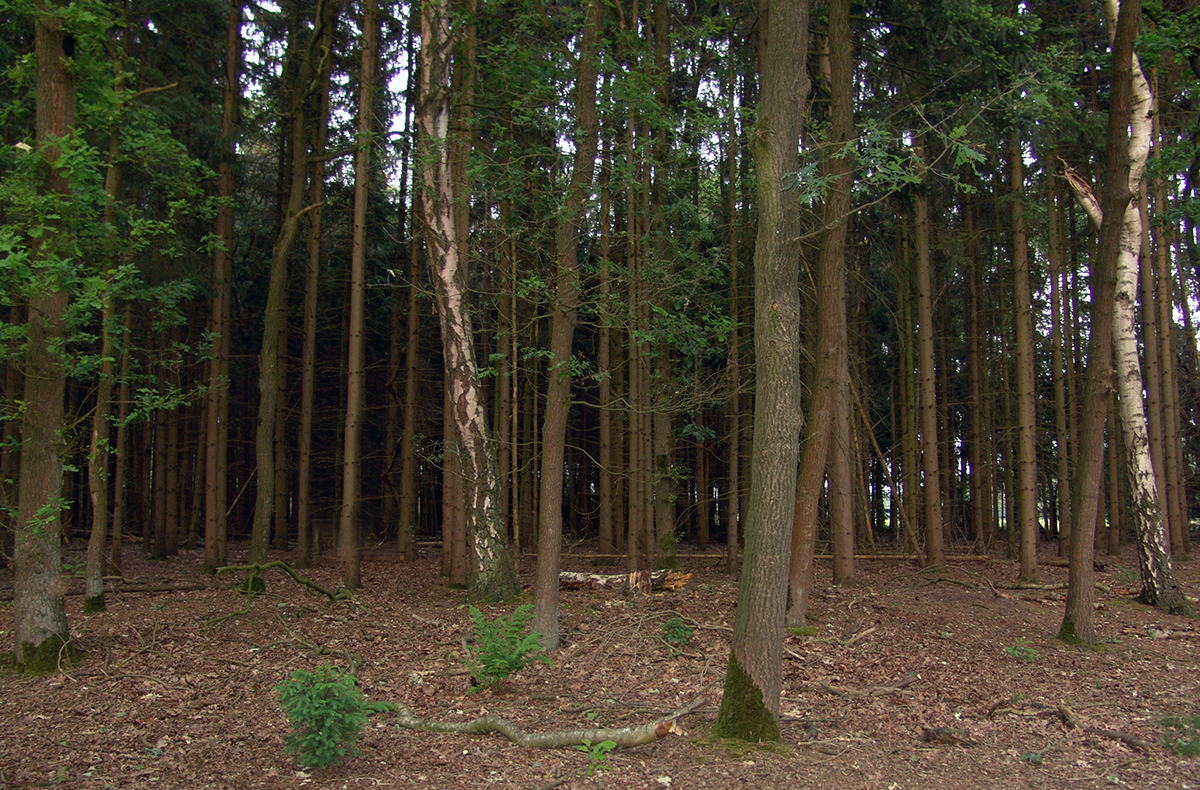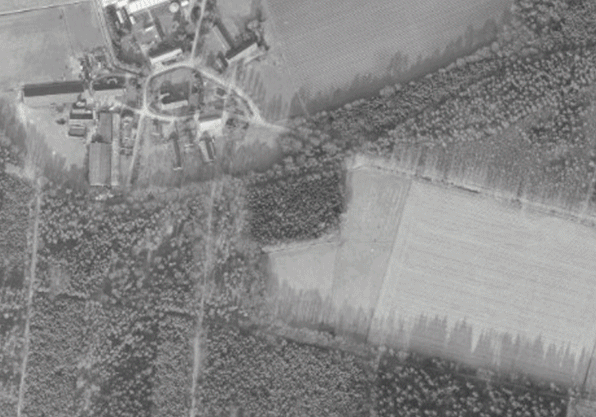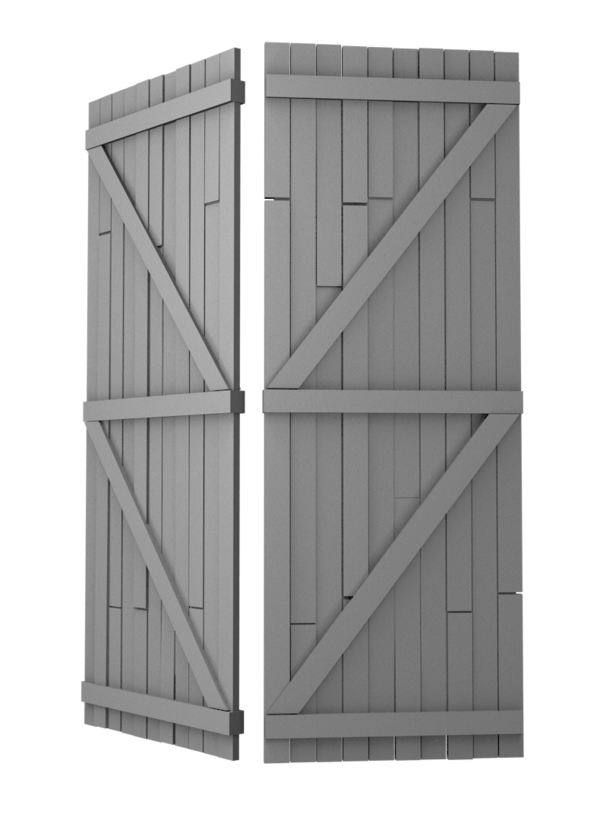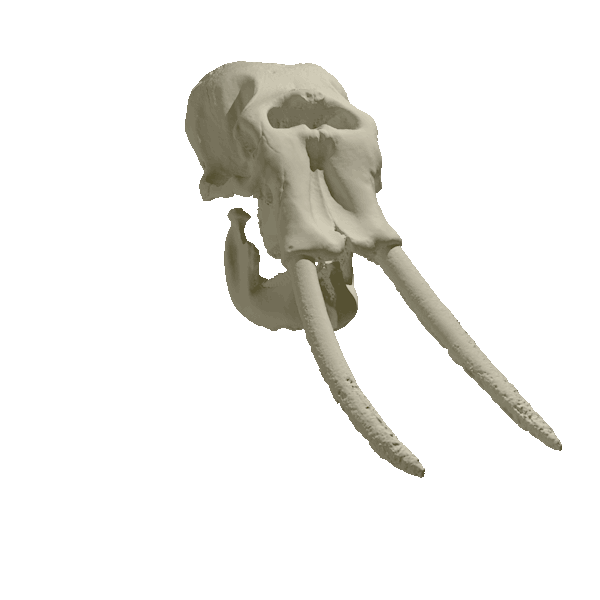The little forest started to show signs of trouble years ago, when some trees were in such bad shape one could simply push them over by hand. This wasn’t merely because of drought: the density of the forest meant the ground couldn't provide enough food for all trees. The sun would barely penetrate the 20 meters high evergreen tree tops, leaving the dark forest almost barren below, except for some ferns and moss. The exception was the South Eastern corner, which had a little more deciduous vegetation and caught a lot more light.
In 2018, after an unusually fierce storm, dozens of trees in the forest were blown over, and began to rot. These trees became the first hosts for Ips typographus, the European spruce bark beetle.
Not only drought has an effect on Ips success to invade hosts, but rising temperatures too help the beetle to thrive. Mild winters reduce mortality amongst larvae and young adults, and warmer springs mean an earlier onset of reproduction, leaving space for two or even three egg-laying events a year, instead of just one.
"The end of nature probably also makes us reluctant to attach ourselves to its remnants, for the same reason that we usually don't choose friends from among the terminally ill.
I love the mountain outside my backdoor... But I know that some part of me resists getting to know it better - for fear, weak-kneed as it sounds, of getting hurt. If I knew as well as a forester what sick trees looked like, I fear I would be seeing them everywhere.
I find now that I like the woods best in winter, when it is harder to tell what might be dying. The winter woods might be perfectly healthy come spring, just as the sick friend, when she's sleeping peacefully, might wake up without the wheeze in her lungs".
Bill McKibben, 'The End of Nature', 1990. Quoted by Glenn A. Albrecht in 'Earth Emotions: New Words for a New World', p. 79, Cornell University Press, Ithaca and London, 2019.
III. The Compositor.
On some Google Maps services, the little forest is still there, looking healthy, dense, and vibrant.
Until the early 1900s, The Plot was part of an area that Dutch maps called ‘woeste gronden’, or rough grounds’: large swaths of undeveloped, sandy soil. Parts of these lands were used as common ground. People would use small, accessible patches near settlements for growing vegetables or keeping cattle. Other parts were used to herd sheep, shaping the landscape into vast areas of heather, dotted with small, shallow lakes.
A remnant of this landscape is now the nature reserve of Strabrechtse Heide. The Plot borders a small forest area marking the transition from agricultural grasslands to heather.
The transition of previous developed woodlands and the heath of the Strabrechtse Heide natural park, November 2020.
Satellite images from 2006 until 2020 showing the evolution and eventual demise of the forest (images via Google Maps)
The artistic record starts in 2011. As a prop for an exhibition narrative, I needed a gate. The Verbeke Foundation was so kind as to provide me with leftover wood.
After the exhibition was dismantled, neither the gallery nor I had space to store the heavy, asymetrical, almost 3 meters high semi-functional sculpture, so I decided it was best to place it in the little forest, raising eyebrows of passing nature lovers.
The gate found a very suitable home there, until it disappeared a couple of month later. Since it was meant to be a portal, its vanishing was unsurprising.
The portal's forces may have been more functional than expected: first the gate went missing, then the whole forest was gone.
Approximate reconstruction of the location of the gate, using a birch tree with its distinctive pattern as guide.
The term Anthropocene has not (yet) been recognized as a geological time division. Some propose the Anthropocene to have started with the dawn of agriculture, making it coincide with the start of the Holocene, thereby making either term obsolete. Others set the start of the Anthropocene after the first evidence of nuclear fallout in 1945.
The Term “Anthropocene” Is Popular—and Problematic by The Scientific American Editors, originally published with the title "Rethinking the “Anthropocene”" in Scientific American 319, 6, 10 (December 2018) doi:10.1038/scientificamerican 1218-10
The Quaternary is the current geological period, starting roughly 2,6 million years ago, coinciding more or less with the emergence of the genus Homo, in the fossil record represented by Homo habilis, the first stone tool maker.
Recurring Ice Ages, alternated by warmer periods characterize the Quaternary, which is divided into two epochs: the Pleistocene and our current era, the Holocene, which is set to begin 11,700 years ago after the last Ice Age ended.
The last glacial period affected the Northern Hemisphere mostly, including the Himalayas, although the glaciers of the Andes Mountain range in South America seem to have expanded significantly in this period as well. The ice sheet - up to 3 kilometers thick in places - never expanded into The Plot, as it may have done in the previous Ice Age.
It’s safe to assume the area would have been an arctic desert or tundra, devoid of trees. Because water was trapped in the ice sheets, sea levels were up to about 125 meters lower than current levels, meaning the British and Irish islands were generously connected to the European mainland. Magnificent wooly mammoths would roam the landscape, as is evidenced by the numerous finds of bones both at the bottom of the North Sea and in gravel excavations near The Plot. Polar winds would bury much of the area with thick sand sheet deposits.
It took about 15.000 years of climate warming between the Glacial Maximum - the peak of the Ice Age - in Europe, and the start of the Holocene. The ice retreated, sea levels rose, precipitation increased, and vegetation returned. On a large time scale, this seems to have taken place gradually.
However, a closer look to all available data collected from pollen, geological records, and isotope dating reveals a capricious cyclic process - the Bond Events - with relapses into colder periods in Europe as recent as 800 to 200 years ago (The ‘Little Ice Age’, well established in 16th and 17th century paintings from the Low Countries).
The steepest increase of sea levels occurred between 15.000 and 10.000 years ago, with sea level rises of 0,23cm per year on average. Between 10 and 5.000 years ago, sea levels still rose, but not quite so much. Afterwards, they stayed more or less on the same level, until the 20th century, when sea levels started to rise with approximately 0,2cm per year. This data is for Western Europe. Global sea and ocean levels don’t rise evenly.
The Holocene is widely expected to be an interglacial period, one way or another.
After the ice retreated, the landscape of The Plot would have oscillated between marshes, dunes, forest and, after the arrival of sheep herding, heather.
The top layer of The Plot is podzol, starting with a layer of humus, followed by relatively poor soils, unsuitable for intensive agriculture. Below this top layer is about 30 meters of Pleistocene sand dunes, deposited by glacial winds. There might be some loam in between, in the South Eastern corner of the area, which is a bit lower and slightly wetter than the rest of The Plot.
Beneath this Ice Age landscape lie the remnants of ancient river bed deposits: a layer of 25 to 35 meters deep of sand and gravel originating from previous waterways of the still existing rivers Maas and Rijn.
Many trees and plants - and consequently animals - that used to thrive in these habitat profiles are now rare or have disappeared due to increased ammonia levels in the ground as a result of the extensive and prolonged use of artificial fertilizer by the surrounding agriculture. This includes the common juniper (Juniperus communis), for instance. 100 Juniper saplings were planted in the Strabrechtse heide. None survived, as per the forester of the natural park.
The Plot is part of two Natura 2000 habitat profiles: 4010 (North Atlantic wet heath with Erica tetralix), and 4030 (European dry heaths). Though seemingly in conflict with each other - wet and dry at the same time - both profiles fit: both holly (dry heath) and elder (wet heath) are sprouting spontaneously on The Plot. Holly is more abundant towards the North Western corner, and elder is quite successful in the lower South Eastern corner.
According to Dutch regulations, a cleared forest has to be reforested within three years. The Province of North Brabant provided me with a list of typical indigenous consistency of trees and shrubs, suitable for the aforementioned habitat profiles:
Tall trees
Silver birch (Betula pendula), European beech (Fagus sylvatica), sessile oak (Quercus petraea), common oak (Quercus robur), black alder (Alnus glutinosa), common hornbeam (Carpinus betulus), European white elm (Ulmus laevis), black poplar (Populus nigra), White willow (Salix alba), Scots pine (Pinus sylvestris)
Shrubs or small trees
Dog rose (Rosa canina), common hazel (Corylus avellana), holly (Ilex aquifolium), rowan (Sorbus aucuparia), single-seeded hawthorn (Crataegus monogyna), mayflower (Crataegus laevigata), European elder (Sambucus nigra), alder buckthorn (Rhamnus frangula), purple willow (Salix purpurea), goat willow (Salix caprea), eared willow (Salix aurita)
Height map of The Plot, showing the original Ice Age sand ridge diagonally across and a depression in the South Eastern corner. Below, a map from 1841. Note the ridge and a small fen. Image via Kadaster (The Netherlands’ Cadastre, Land Registry and Mapping Agency) / www.topotijdreis.nl
Natura 2000 beheerplan Strabrechtse Heide en Beuven, Staatsbosbeheer, 2016, p. 24-28, Province of North Brabant and natura2000.nl/profielen
The soil from a small bore hole at The Plot, July 2020, showing a typical podzol consistency. The hole was made in the lower South Eastern corner, in search for the ground water level. At 1.20m deep, no water was found.
Is it better to already start to plant trees that are more at home in dryer and hotter climates?
When does a forest become a park?
Is doing nothing an option? Does that count as reforesting? Are we right to take out invasive species such as Black Cherry or Northern Red Oak?
Archaeological evidence shows hunter/gatherer tribes roaming the current Province of North Brabant, where The Plot is located, between about 10.000 years ago and 3.000 ya. After this, scattered settlements of agricultural societies would sprout up. However, there’s no sign of this on The Plot itself.
In 1910, a gilt silver Roman helmet from 319-323 CE was found in the moors of Deurne about 20km East. The helmet is now part of the collection of the National Museum of Antiquities in Leiden (NL).
The township of Moorsel, just across the sand path to the North of The Plot probably was erected in the 12th century, when it became a farm of the abbey of Floreffe - which is 140km to the South in present day Belgium - although administration would’ve been done from the abbey of Postel, 40km away. The original horseshoe shaped boundaries of the settlement are still recognizable in the landscape, and makes it easy to locate The Plot on historical maps.
A wooded sand wall protected the farmland from drifting sand, coming from the bordering heath land - which included The Plot. This feature is still there, though not as pronounced as it used to be. There’s some speculation that, based on the soil profile, the wall may be much older, even going as far back as the iron age.
Politically, the first time The Plot was recorded to be part of an administration was during the Roman Empire, when it fell under the district Civitas Tungrorum. Its people were known, amongst other names, as the Eburones. That name is likely derived from the Gaulish word for yew tree, eburos. The yew tree (Taxus baccata) is a poisonous conifer, and the story goes that the Eburonian king Cativolcus committed ritualistic suicide in 53 BCE by drinking a poison made from this tree, after Julius Caesar conquered his lands. After this, the people from the area between the Rhine river and river Scheldt were called Texandri. Little is known about these folks.
The tribes were of uncertain ethnicity, somewhere between Germanic and Celtic. The Texandri became the Franks, who turned into the Merovians and, under the rule of Charlemagne, the Carolingians. After Charlemagne’s sons had divided his empire, (Lower) Lotharingia completely shattered and The Plot became a fringe of the Prince-Bishopric of Liège or the Duchy of Brabant in the Holy Roman Empire. Brabant then became part of the Burgondian state, and, from the 1550s on, allied with the Union of The Netherlands’ seventeen provinces.
In recorded history, The Plot only came close a couple of times to being part of any kind of historical upheaval. In the notorious Summer of the year 1595 a wave of witch trials terrorized the area. At the time, The Plot was indirectly under Spanish rule, and the inquisitorial system the king of Spain had authorized a couple of years before was grossly misused by people, including a local lord.
In an age and area defined by wars, poverty, failed harvests and plagues 38 women and 2 men were, within the timespan of only a couple of months, accused of witchcraft. In total 25 women died: 23 by strangulation, which was considered to be a merciful manner of execution. Immediately after the women were strangled, their corpses were burned at the stake. Of those women, 15 came from the villages of Lierop and Mierlo, and were tried at the Hoenderboom, a tree near the Grafven (Grave fen), which is on the Strabrechtse heide.
The route from both Lierop and Mierlo to the execution place could very well have led the accused through Moorsel, passing The Plot more or less on its way.
A genealogical search reveals one of my ancestors - through my grandfather’s mother’s side - was an alderman of Lierop at the time of the trials. Anthonis Vlemmincx (1535-1604) is recorded to have property in the village.
Although he was part of the village’s administration, there’s no mention of him being part of the witch trials - although he undoubtedly must have been aware of them.
Aldermans were appointed at the time, and declining the honour was not an option. The least you can say of Anthonis is that he didn’t stop the trials, whether he wanted to or not.
























